Derui Wang
Minhui
SafeSpeech: Robust and Universal Voice Protection Against Malicious Speech Synthesis
Apr 14, 2025



Abstract:Speech synthesis technology has brought great convenience, while the widespread usage of realistic deepfake audio has triggered hazards. Malicious adversaries may unauthorizedly collect victims' speeches and clone a similar voice for illegal exploitation (\textit{e.g.}, telecom fraud). However, the existing defense methods cannot effectively prevent deepfake exploitation and are vulnerable to robust training techniques. Therefore, a more effective and robust data protection method is urgently needed. In response, we propose a defensive framework, \textit{\textbf{SafeSpeech}}, which protects the users' audio before uploading by embedding imperceptible perturbations on original speeches to prevent high-quality synthetic speech. In SafeSpeech, we devise a robust and universal proactive protection technique, \textbf{S}peech \textbf{PE}rturbative \textbf{C}oncealment (\textbf{SPEC}), that leverages a surrogate model to generate universally applicable perturbation for generative synthetic models. Moreover, we optimize the human perception of embedded perturbation in terms of time and frequency domains. To evaluate our method comprehensively, we conduct extensive experiments across advanced models and datasets, both subjectively and objectively. Our experimental results demonstrate that SafeSpeech achieves state-of-the-art (SOTA) voice protection effectiveness and transferability and is highly robust against advanced adaptive adversaries. Moreover, SafeSpeech has real-time capability in real-world tests. The source code is available at \href{https://github.com/wxzyd123/SafeSpeech}{https://github.com/wxzyd123/SafeSpeech}.
Whispering Under the Eaves: Protecting User Privacy Against Commercial and LLM-powered Automatic Speech Recognition Systems
Apr 01, 2025Abstract:The widespread application of automatic speech recognition (ASR) supports large-scale voice surveillance, raising concerns about privacy among users. In this paper, we concentrate on using adversarial examples to mitigate unauthorized disclosure of speech privacy thwarted by potential eavesdroppers in speech communications. While audio adversarial examples have demonstrated the capability to mislead ASR models or evade ASR surveillance, they are typically constructed through time-intensive offline optimization, restricting their practicality in real-time voice communication. Recent work overcame this limitation by generating universal adversarial perturbations (UAPs) and enhancing their transferability for black-box scenarios. However, they introduced excessive noise that significantly degrades audio quality and affects human perception, thereby limiting their effectiveness in practical scenarios. To address this limitation and protect live users' speech against ASR systems, we propose a novel framework, AudioShield. Central to this framework is the concept of Transferable Universal Adversarial Perturbations in the Latent Space (LS-TUAP). By transferring the perturbations to the latent space, the audio quality is preserved to a large extent. Additionally, we propose target feature adaptation to enhance the transferability of UAPs by embedding target text features into the perturbations. Comprehensive evaluation on four commercial ASR APIs (Google, Amazon, iFlytek, and Alibaba), three voice assistants, two LLM-powered ASR and one NN-based ASR demonstrates the protection superiority of AudioShield over existing competitors, and both objective and subjective evaluations indicate that AudioShield significantly improves the audio quality. Moreover, AudioShield also shows high effectiveness in real-time end-to-end scenarios, and demonstrates strong resilience against adaptive countermeasures.
CAMP in the Odyssey: Provably Robust Reinforcement Learning with Certified Radius Maximization
Jan 29, 2025



Abstract:Deep reinforcement learning (DRL) has gained widespread adoption in control and decision-making tasks due to its strong performance in dynamic environments. However, DRL agents are vulnerable to noisy observations and adversarial attacks, and concerns about the adversarial robustness of DRL systems have emerged. Recent efforts have focused on addressing these robustness issues by establishing rigorous theoretical guarantees for the returns achieved by DRL agents in adversarial settings. Among these approaches, policy smoothing has proven to be an effective and scalable method for certifying the robustness of DRL agents. Nevertheless, existing certifiably robust DRL relies on policies trained with simple Gaussian augmentations, resulting in a suboptimal trade-off between certified robustness and certified return. To address this issue, we introduce a novel paradigm dubbed \texttt{C}ertified-r\texttt{A}dius-\texttt{M}aximizing \texttt{P}olicy (\texttt{CAMP}) training. \texttt{CAMP} is designed to enhance DRL policies, achieving better utility without compromising provable robustness. By leveraging the insight that the global certified radius can be derived from local certified radii based on training-time statistics, \texttt{CAMP} formulates a surrogate loss related to the local certified radius and optimizes the policy guided by this surrogate loss. We also introduce \textit{policy imitation} as a novel technique to stabilize \texttt{CAMP} training. Experimental results demonstrate that \texttt{CAMP} significantly improves the robustness-return trade-off across various tasks. Based on the results, \texttt{CAMP} can achieve up to twice the certified expected return compared to that of baselines. Our code is available at https://github.com/NeuralSec/camp-robust-rl.
Mitigating Unauthorized Speech Synthesis for Voice Protection
Oct 28, 2024



Abstract:With just a few speech samples, it is possible to perfectly replicate a speaker's voice in recent years, while malicious voice exploitation (e.g., telecom fraud for illegal financial gain) has brought huge hazards in our daily lives. Therefore, it is crucial to protect publicly accessible speech data that contains sensitive information, such as personal voiceprints. Most previous defense methods have focused on spoofing speaker verification systems in timbre similarity but the synthesized deepfake speech is still of high quality. In response to the rising hazards, we devise an effective, transferable, and robust proactive protection technology named Pivotal Objective Perturbation (POP) that applies imperceptible error-minimizing noises on original speech samples to prevent them from being effectively learned for text-to-speech (TTS) synthesis models so that high-quality deepfake speeches cannot be generated. We conduct extensive experiments on state-of-the-art (SOTA) TTS models utilizing objective and subjective metrics to comprehensively evaluate our proposed method. The experimental results demonstrate outstanding effectiveness and transferability across various models. Compared to the speech unclarity score of 21.94% from voice synthesizers trained on samples without protection, POP-protected samples significantly increase it to 127.31%. Moreover, our method shows robustness against noise reduction and data augmentation techniques, thereby greatly reducing potential hazards.
Query-Efficient Video Adversarial Attack with Stylized Logo
Aug 22, 2024Abstract:Video classification systems based on Deep Neural Networks (DNNs) have demonstrated excellent performance in accurately verifying video content. However, recent studies have shown that DNNs are highly vulnerable to adversarial examples. Therefore, a deep understanding of adversarial attacks can better respond to emergency situations. In order to improve attack performance, many style-transfer-based attacks and patch-based attacks have been proposed. However, the global perturbation of the former will bring unnatural global color, while the latter is difficult to achieve success in targeted attacks due to the limited perturbation space. Moreover, compared to a plethora of methods targeting image classifiers, video adversarial attacks are still not that popular. Therefore, to generate adversarial examples with a low budget and to provide them with a higher verisimilitude, we propose a novel black-box video attack framework, called Stylized Logo Attack (SLA). SLA is conducted through three steps. The first step involves building a style references set for logos, which can not only make the generated examples more natural, but also carry more target class features in the targeted attacks. Then, reinforcement learning (RL) is employed to determine the style reference and position parameters of the logo within the video, which ensures that the stylized logo is placed in the video with optimal attributes. Finally, perturbation optimization is designed to optimize perturbations to improve the fooling rate in a step-by-step manner. Sufficient experimental results indicate that, SLA can achieve better performance than state-of-the-art methods and still maintain good deception effects when facing various defense methods.
Rethinking the Threat and Accessibility of Adversarial Attacks against Face Recognition Systems
Jul 11, 2024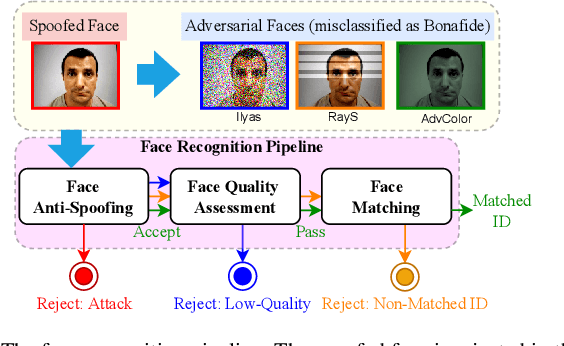
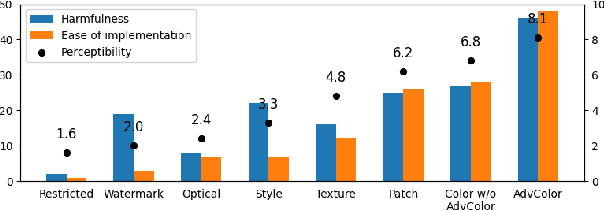
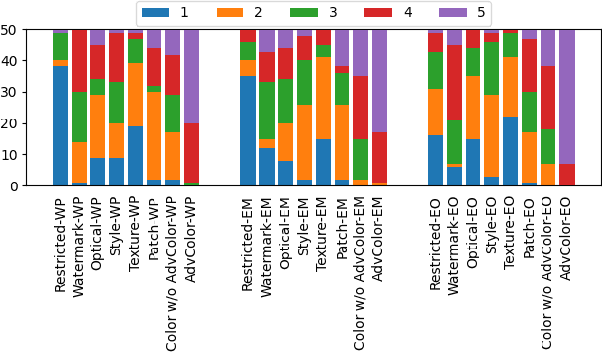

Abstract:Face recognition pipelines have been widely deployed in various mission-critical systems in trust, equitable and responsible AI applications. However, the emergence of adversarial attacks has threatened the security of the entire recognition pipeline. Despite the sheer number of attack methods proposed for crafting adversarial examples in both digital and physical forms, it is never an easy task to assess the real threat level of different attacks and obtain useful insight into the key risks confronted by face recognition systems. Traditional attacks view imperceptibility as the most important measurement to keep perturbations stealthy, while we suspect that industry professionals may possess a different opinion. In this paper, we delve into measuring the threat brought about by adversarial attacks from the perspectives of the industry and the applications of face recognition. In contrast to widely studied sophisticated attacks in the field, we propose an effective yet easy-to-launch physical adversarial attack, named AdvColor, against black-box face recognition pipelines in the physical world. AdvColor fools models in the recognition pipeline via directly supplying printed photos of human faces to the system under adversarial illuminations. Experimental results show that physical AdvColor examples can achieve a fooling rate of more than 96% against the anti-spoofing model and an overall attack success rate of 88% against the face recognition pipeline. We also conduct a survey on the threats of prevailing adversarial attacks, including AdvColor, to understand the gap between the machine-measured and human-assessed threat levels of different forms of adversarial attacks. The survey results surprisingly indicate that, compared to deliberately launched imperceptible attacks, perceptible but accessible attacks pose more lethal threats to real-world commercial systems of face recognition.
QUEEN: Query Unlearning against Model Extraction
Jul 01, 2024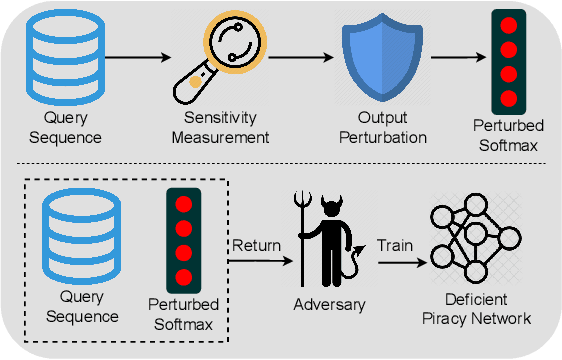
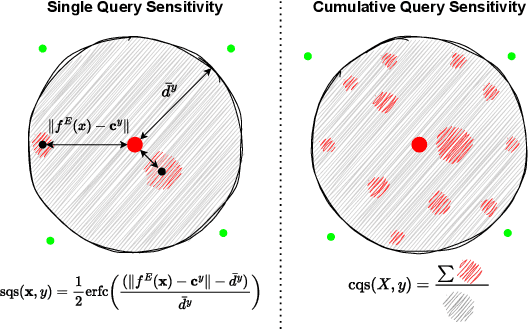
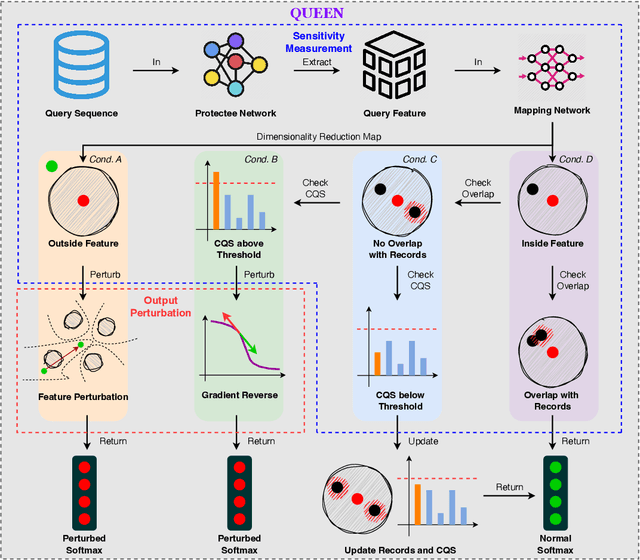

Abstract:Model extraction attacks currently pose a non-negligible threat to the security and privacy of deep learning models. By querying the model with a small dataset and usingthe query results as the ground-truth labels, an adversary can steal a piracy model with performance comparable to the original model. Two key issues that cause the threat are, on the one hand, accurate and unlimited queries can be obtained by the adversary; on the other hand, the adversary can aggregate the query results to train the model step by step. The existing defenses usually employ model watermarking or fingerprinting to protect the ownership. However, these methods cannot proactively prevent the violation from happening. To mitigate the threat, we propose QUEEN (QUEry unlEarNing) that proactively launches counterattacks on potential model extraction attacks from the very beginning. To limit the potential threat, QUEEN has sensitivity measurement and outputs perturbation that prevents the adversary from training a piracy model with high performance. In sensitivity measurement, QUEEN measures the single query sensitivity by its distance from the center of its cluster in the feature space. To reduce the learning accuracy of attacks, for the highly sensitive query batch, QUEEN applies query unlearning, which is implemented by gradient reverse to perturb the softmax output such that the piracy model will generate reverse gradients to worsen its performance unconsciously. Experiments show that QUEEN outperforms the state-of-the-art defenses against various model extraction attacks with a relatively low cost to the model accuracy. The artifact is publicly available at https://anonymous.4open.science/r/queen implementation-5408/.
Optimizing Cyber Defense in Dynamic Active Directories through Reinforcement Learning
Jun 28, 2024
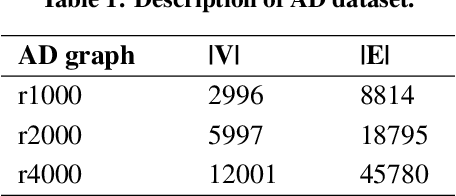


Abstract:This paper addresses a significant gap in Autonomous Cyber Operations (ACO) literature: the absence of effective edge-blocking ACO strategies in dynamic, real-world networks. It specifically targets the cybersecurity vulnerabilities of organizational Active Directory (AD) systems. Unlike the existing literature on edge-blocking defenses which considers AD systems as static entities, our study counters this by recognizing their dynamic nature and developing advanced edge-blocking defenses through a Stackelberg game model between attacker and defender. We devise a Reinforcement Learning (RL)-based attack strategy and an RL-assisted Evolutionary Diversity Optimization-based defense strategy, where the attacker and defender improve each other strategy via parallel gameplay. To address the computational challenges of training attacker-defender strategies on numerous dynamic AD graphs, we propose an RL Training Facilitator that prunes environments and neural networks to eliminate irrelevant elements, enabling efficient and scalable training for large graphs. We extensively train the attacker strategy, as a sophisticated attacker model is essential for a robust defense. Our empirical results successfully demonstrate that our proposed approach enhances defender's proficiency in hardening dynamic AD graphs while ensuring scalability for large-scale AD.
Effects of Exponential Gaussian Distribution on (Double Sampling) Randomized Smoothing
Jun 04, 2024

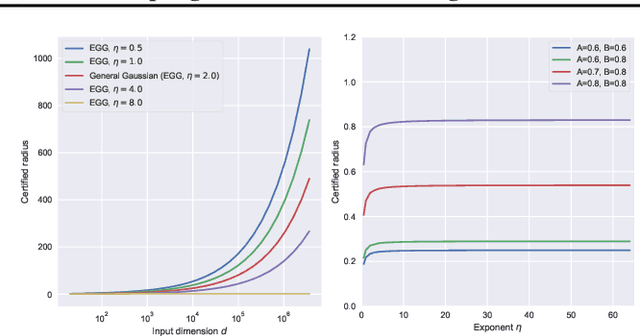

Abstract:Randomized Smoothing (RS) is currently a scalable certified defense method providing robustness certification against adversarial examples. Although significant progress has been achieved in providing defenses against $\ell_p$ adversaries, the interaction between the smoothing distribution and the robustness certification still remains vague. In this work, we comprehensively study the effect of two families of distributions, named Exponential Standard Gaussian (ESG) and Exponential General Gaussian (EGG) distributions, on Randomized Smoothing and Double Sampling Randomized Smoothing (DSRS). We derive an analytic formula for ESG's certified radius, which converges to the origin formula of RS as the dimension $d$ increases. Additionally, we prove that EGG can provide tighter constant factors than DSRS in providing $\Omega(\sqrt{d})$ lower bounds of $\ell_2$ certified radius, and thus further addresses the curse of dimensionality in RS. Our experiments on real-world datasets confirm our theoretical analysis of the ESG distributions, that they provide almost the same certification under different exponents $\eta$ for both RS and DSRS. In addition, EGG
Towards Evaluating the Robustness of Automatic Speech Recognition Systems via Audio Style Transfer
May 15, 2024



Abstract:In light of the widespread application of Automatic Speech Recognition (ASR) systems, their security concerns have received much more attention than ever before, primarily due to the susceptibility of Deep Neural Networks. Previous studies have illustrated that surreptitiously crafting adversarial perturbations enables the manipulation of speech recognition systems, resulting in the production of malicious commands. These attack methods mostly require adding noise perturbations under $\ell_p$ norm constraints, inevitably leaving behind artifacts of manual modifications. Recent research has alleviated this limitation by manipulating style vectors to synthesize adversarial examples based on Text-to-Speech (TTS) synthesis audio. However, style modifications based on optimization objectives significantly reduce the controllability and editability of audio styles. In this paper, we propose an attack on ASR systems based on user-customized style transfer. We first test the effect of Style Transfer Attack (STA) which combines style transfer and adversarial attack in sequential order. And then, as an improvement, we propose an iterative Style Code Attack (SCA) to maintain audio quality. Experimental results show that our method can meet the need for user-customized styles and achieve a success rate of 82% in attacks, while keeping sound naturalness due to our user study.
 Add to Chrome
Add to Chrome Add to Firefox
Add to Firefox Add to Edge
Add to Edge